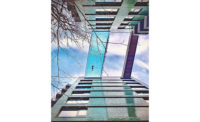"We have 5.85 million square feet currently occupied, including the 855,000 square feet we've built out this year alone," says Mike Bell, the real estate development firm's general manager. "There's roughly 55 million sq ft of open space down here, though, so we have room to expand." The owner plans to build out another 8 million sq ft soon.
The mid-1940s mine, which was excavated through a 270-million-year-old limestone deposit using the room-and-pillar method, continued to operate through the end of the last century. SubTropolis first opened in 1964 to house tenants such as Pillsbury, Russell Stover and Ford. Material removed from the mine went into many local roads and buildings, including runways at nearby Kansas City International Airport.
Early on, miners spaced the pillars in an irregular fashion. As the owner saw the mine's potential value as a warehouse, the space finally consisted of pillars shaped 25 ft sq on 65-ft centers, leaving 40 ft of open space between 16- to 17-ft-high ceilings.
That flexibility was a key factor in current tenant Food Service Warehouse's decision to trade its present 200,000-sq-ft SubTropolis location for a custom- designed 475,000-sq-ft underground space, now under construction.
"Our business has been growing very rapidly over the past few years, and one of the unique features of our new SubTropolis facility is that Hunt Midwest has reserved additional space for us next door," says Kristofer Bain, company vice president. "So, when the time comes, we can expand our operation to 800,000 square feet without the hassles of building a whole new building on the surface."
Aside from the lower construction costs, executives at Hunt Midwest say tenants like the underground business park's added security and reduced energy requirements, allowing them to afford more space than in an aboveground structure. On average, SubTropolis saves tenants 50% to 70% on energy and 30% to 50% on lease rates, according to the owner.
Creating the leasable space is not always easy, though. Before offering space to tenants, Hunt Midwest must build roads, water, sewer, fire-sprinkler and electrical services. When floor-to-ceiling heights are not regular, the owner brings in a crew to fine-tune the rock structure.
Working under temporary road lights, contractors typically use a road-milling machine to smooth out cavern interiors. However, the limestone is about six times stronger than concrete, so the milling teeth need to be replaced about once an hour—more often than on a pavement job. Although the built-out space now features more than six miles of paved roads and two miles of railroad track, some parts of the mine still have been in the dark for 30 years.
Among finished spaces, natural ventilation is enough to keep fresh air flowing in the business park, and the floor slabs are usually no thicker than 4 in., thanks to the rock-solid environment.
"The concrete floors don't need to be very thick since they are bearing on a layer of solid limestone," Meyer notes. "You can't get a better subgrade for a concrete floor slab."






Post a comment to this article
Report Abusive Comment